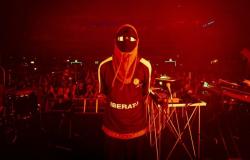Anyone who knows us knows that some of us like Týr and we’ve been following them for a long time, me in particular since the first album. The Faroese group has been active for more than twenty years and has gone through various style changes, as happens to many artists. With the first three albums How Far to Asgaard (2002), Eric the Red (2003) e Ragnarok (2006) established themselves with an epic metal highly contaminated by Nordic folk and with a strong prog tendency. Land (2008) continued on this path, but represented a more introspective and meditative moment, very original and interesting, even if not easy to assimilate. They were decidedly more inclined towards power By the Light of the Northern Star (2009) e The Lay of Thrym (2011). They were even more powerful Valkyrja (2013) e Hel (2019), produced with a modernist sound and which marked a continuation towards a more refined, but also less spontaneous style, although in every Týr album there has always been something original and personal, if only for their boundless passion towards the Faroes, with their literary and musical heritage.
With this Battle Ballads we find ourselves in a new phase of Týr, or what we could define symphonic. We had a first demonstration of this trend with A Night at the Nordic House of 2022, a live recording with the Faroe Symphony Orchestra. It seems that Heri Joensen and her companions liked this experience, so much so that it encouraged them to continue with the help of the orchestra for the studio album. The idea they initially had was to record the album together with the orchestra, however there were scheduling problems for both of them and so the orchestral parts were added after Týr’s recording, by the producer Jacob Hansen (Volbeat, Amaranthe).
As with other Týr albums, it took me a few days to understand whether I really liked this one or not. It is certainly an album of songs, of dance as the title says, that is, songs that are direct and simple in structure, but not therefore immediate to understand. We know that Týr are good, they know how to compose, they know how to capture and strike certain chords in the listener. However, while I continue to respect them a lot, I must say that two songs of the whole album really struck me: the single Axes it’s the last one Latronum Normannorum cause. There are other interesting moments to discover, such as the acoustics Torkils Døturwhich is a slow and melancholy version of a folk dance, as well as Vælkomnir føroyingar is the energetic and cheerful interpretation of a poem by the politician and writer Jóannes Patursson.
What you sense is a genuine inspiration and always the same desire to talk about their land, so much so that Heri and his companions are the best ambassadors of the Faroes for the world. They are committed to publishing articles and videos about the landscape, the traditions, the language, but here, as in the last Týr albums, more work on the compositional side is missing. In this regard, the choice to add the orchestra is not helpful, as it obviously shifts the attention only to aesthetics and distracts it from the musical material. This drift could also be the fault of Metal Bladebut for years now the formula of each album has always been the same and to me I really miss their old riffs, which made you feel the icy wind, the snow-covered fjords and the mead horn.
Finally, we take this opportunity to inform you that the Napalm Recordsthe label that released Týr da Ragnarok until The Lay of Thrymwill very soon release a collection entitled The Best of the Napalm Years. It won’t have all the most significant pieces from the past, but it will still be a good review of their best period.
Returning for one last moment to Battle Balladsthe title of the last song, the aforementioned one Latronum Normannorum cause it is taken from Liber de Mensura Orbis Terrae written in 825 by the monk Say, who first visited the Faroe Islands. Of these, he said that they had been inhabited by some Irish around the 8th century, who remained there for about a century, but then had to flee due to the continuous invasions of Vikings. The Latin refrain of the song freely quotes a particular passage from the book.
However, remember that the first Faroese-Italian dictionary was published by a fellow citizen of mine, Gianfranco Contri (Faroese – Italian Dictionary Føroysk-italska orðabókFøroya Fródskaparfelag, Tórshavn, 2004), originally from Riolunato. (Stefano Mazza)






